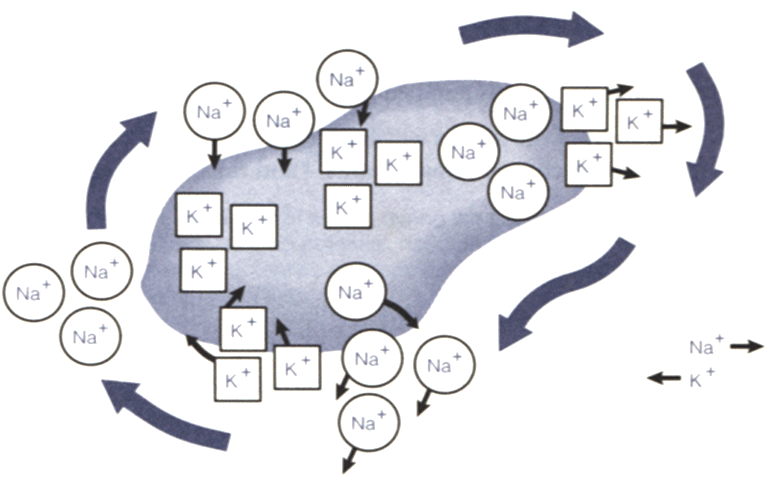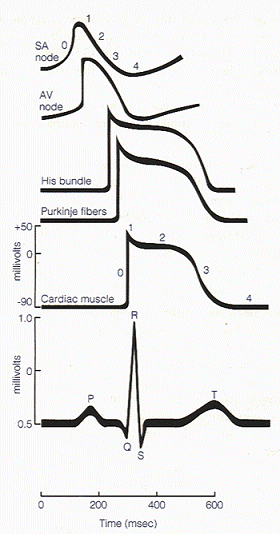The Action Potential
A voltage difference exists across the membranes of almost all cells in the body. In physiology, this action potential occurs in excitable cells such as neurons, muscle cells, and the beta cells in the pancreas. An action potential is the short-lasting event in which the electrical membrane potential of a cell rapidly rises and falls, following a consistent trajectory. In myocardial cells, this is the first step in the chain of events leading to the contraction/relaxation process that gives you a heartbeat.
Concentrations of ionic solutions in the fluid inside and outside of the cell membrane make the flow of electrical current possible. In the myocardium, special types of voltage-gated channels embedded in the cell’s plasma membrane allow sodium, potassium and calcium ions to transmit current throughout the myocardium. A resting cell stimulated by an impulse from the cardiac conduction system begins a sequence of rapid changes in membrane potential affecting the permeability of the cell membrane and the movement of ions (electrical charge) into and out of the cell.
THE ACTION POTENTIAL
A resting cell stimulated by an impulse from the cardiac conduction system begins a sequence of rapid changes in membrane potential affecting the permeability of the cell membrane and the movement of ions (electrical charge) into and out of the cell.
This sequence of changes is called the action potential.
Characteristics of the cell membrane such as selectively allowing ions through the membrane under certain conditions, ionic imbalance within and outside the cell membrane, the presence of certain neurotransmitters, and a specialized conduction system create a system that moves current through tissues that result in the contraction and relaxation of muscle tissue, repeatedly, to keep your heart beating for a lifetime.
The following conditions explain the phenomenon of myocardial
contraction:
- Selective Permeability The Na+ concentration outside the cell is many times greater than the intracellular concentration.The K+ concentration is about 35 times greater inside the cell than outside. The K+ ions are accompanied by large negatively charged organic molecules which remain within the cell.
- Passive Transport The resting cell membrane may be 50-100 times more permeable to K+ than Na+.In the resting cell there is some movement of sodium and potassium in both directions.K+ diffuses through the membrane relatively easily. This is a passive transport mechanism.
- Active Transport Active transport is the movement of sodium out of the cell and movement of potassium into the cell against their respective concentration gradients.In the heart, the cardiac muscle cell acts as a pump. The sodium-potassium pump describes the mechanism by which sodium ions are driven out of the cell while potassium ions are pulled in.The unequal distribution of electrolytes between the intracellular and extracellular compartments has particular importance in cells that transmit electrical impulses.
- The Cell Membrane Potential All electrical activity depends on a difference in potential. A voltage difference, which is called “electrical potential”, exists across the membrane of almost all cells of the body. The
membrane resting potential is around 70 to 90 millivolts.The resting, or polarized, cell is primarily negatively charged inside and positively charged outside. - The Action Potential Depolarization of the myocardial cells results in contraction, or atrial and ventricular systole. During repolarization, the resting state is restored, and the chambers once again fill with blood.
In the resting cell there is some movement of sodium and potassium in both directions. The sodium-potassium pump actively transports K+ across the cell membrane to the inside and simultaneously transports Na+ out of the cell. The energy for the pumping mechanism is supplied by the breakdown of ATP.  Illustration credit: English, Carol A.,et al, Introduction to Nuclear Cardiology, Third Edition, 1993, DuPont Pharma
Illustration credit: English, Carol A.,et al, Introduction to Nuclear Cardiology, Third Edition, 1993, DuPont Pharma
An excess of positive charges accumulate on the outside of the cell membrane. When the threshold is reached, ionic gates open in the membrane. Sodium ions, and the positive charges carried with them, gush back into the cell. This rapid shift in positive charges is called depolarization, and it creates an electrical current.
Quickly the ions are pumped back out again, during the stage termed repolarization. Depolarization in the SA node is the event that sparks off a heartbeat. Waves of depolarization speed along the cell membranes and conduction pathways through the heart. When they reach the terminals of the Purkinje fibers they leap across to the cardiac muscle fibers and set in motion the molecular ratchets of actin and myosin, which slide past each other to shorten the fiber. All this happens in less than a second.
In the following illustration, the upper curves represent the action potential for the specialized cells of the cardiac conduction system and for a ventricular muscle cell during one complete cycle. Note how the pacemaker cells fire off sequentially from SA node to Purkinje fibers. Note also the difference between pacemaker and myocardial cells; the pacemaker cells automatically depolarize during diastole while myocardial muscle cells, which remain polarized during diastole, require an outside stimulus to depolarize. The lower curves demonstrate the corresponding normal ECG.
Illustration credit: English, Carol A.,et al, Introduction to Nuclear Cardiology, Third Edition, 1993, DuPont Pharma
- A sodium-potassium pump mechanism actively transports sodium to the outside and potassium to the inside.
- The resting cell membrane is much more permeable to potassium- perhaps 50-100 times as much- which allows potassium to diffuse through the membrane relatively easily while sodium diffuses with difficulty. This is a passive transport mechanism.
- Inside the cell are large numbers of heavy, negatively charged molecules that cannot normally diffuse through the membrane.
- There is a net outward movement of positive ions, since two to five sodium ions are pumped out of the cell for every potassium ion that is pumped in.
- Since most of the anions within the cell are nondiffusible, the negative charges remain inside- and the cell becomes polarized

